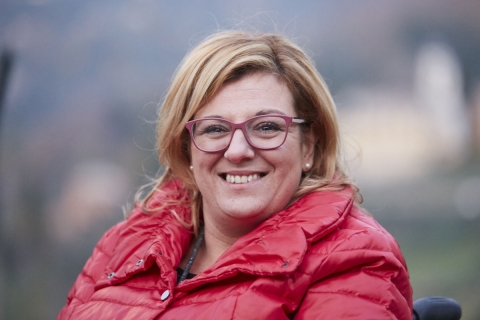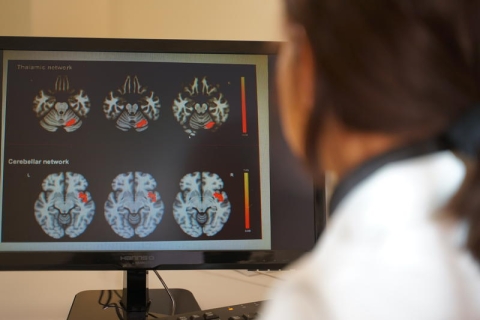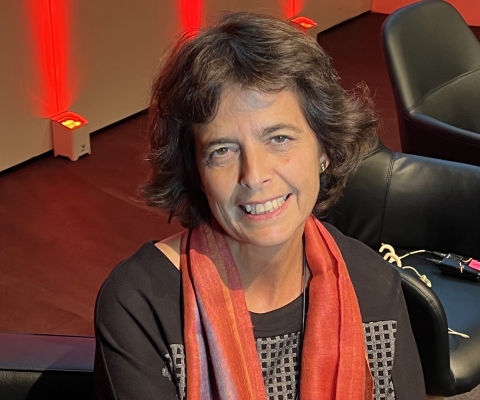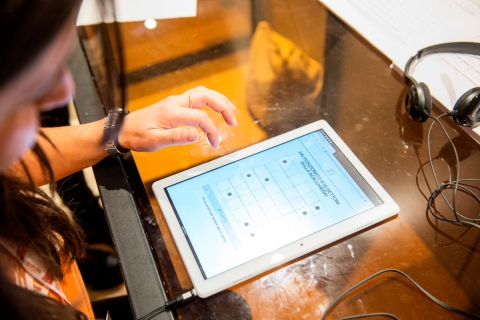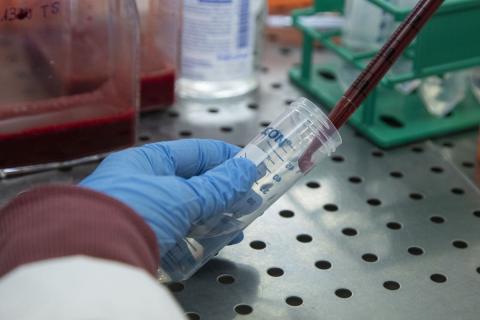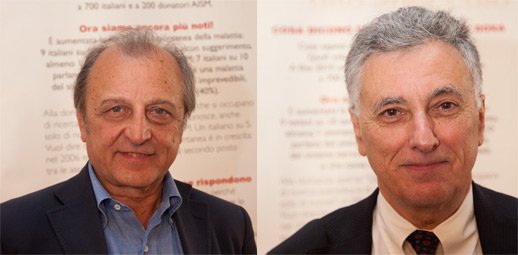
In the picture: Giancarlo Comi (left) and Gianluigi Mancardi (right)
“97% of people suffering from MS does not have the CCSVI. Similar percentages in healthy controls and patients suffering from other neurodegenerative diseases show that there is no correlation between CCSVI and SM”
CoSMo has recently concluded and now publishes its results. The observational study between the possible link between CCSVI and multiple sclerosis has been entirely financed by the Italian MS Society (AISM) through its Foundation FISM, with an investment of 1.5 million Euros. AISM kept its promise: finding the answers that people with SM were strongly seeking to make free choices thus safeguarding and asserting peoples’ fundamental right to health. Today patients with MS are getting clear and precise answers about if and how CCSVI affects and has an incidence on multiple sclerosis. And, therefore, everyone is able to choose if and how venous insufficiency should be cured.
In order to present the results of such innovative study within its extremely articulated and complex framework, we interviewed the two ‘principal investigators’ of the study, professor Giancarlo Comi, Università Vita e Salute San Raffaele – Milan and professor Gianluigi Mancardi, Genoa University. Comi is Chairman of the Italian Neurological Society and a member of the Italian MS Society's board of directors . Mancardi is Chairman of the AISM scientific Committee.
CoSMo is an observational study on the prevalence of CCSVI in MS: what was its main objective?
[Comi]: «The primary objective was to answer a simple question: «is CCSVI linked to multiple sclerosis?».
Why did the AISM Foundation invest so much and run against time just to answer this question ?
[Mancardi]: «AISM, the scientific community and especially the patients affected by MS desired to finally solve the issue on the possible prevalence of CCSVI in MS and its influence on the evolution of the illness. It was necessary to quickly find an explanatory answer because this problem strongly concerned and confused the Italian community of people with MS. The issue raised a huge media clamour, whereas the first scientific studies provided very conflicting reports: some referred an effect of CCSVI in 100% of the studied cases with multiple sclerosis, other referred a total absence (0%) of CCSVI. We had to put uncertainties behind us. People have a right to know how they should treat themselves efficiently and safely.
[Comi] Also in line with the common practice to surgically intervene on people even before the least assessment on the safety and efficiency of CCSVI treatments, in Italy we are seriously running the risk of impairing the health of already sick people, as well as dipping into their savings. We had to reassure people over what it is more appropriate to do. Therefore, AISM along with its Foundation FISM, aware of its responsibilities, felt duty bound to invest a great deal of resources, even in a period when the entire nation is suffering economic recession. The investment was decided by the FISM Board of Directors after an attentive, but also difficult evaluation of pros and cons.
How did you work out a response to the question in play? Which persons were studied?
[Mancardi]: «The study was conducted on 1165 people with MS, compared with 376 healthy controls and 226 patients with other neurological diseases. A total of 1867 people were recruited. 45 people were excluded from the assessment for technical reasons because the exam was not readable. Other 64 were excluded because not compliant to the protocol: for example because the patients' age was lower or greater than required. The final assessment was therefore performed on 1767 patients».
Who analyzed the patients, using which technique ?
[Comi]: «The patients were recruited in 35 multiple sclerosis centres distributed over the Italian territory. Each of them underwent ecocolor Doppler exams, video clips and images were gathered from the 26 neurosonologists».
How were the examinations performed, read and reported?
[Mancardi]: «According to the criteria of the person who first described it (i.e. professor Paolo Zamboni) 2 out of 5 alterations were to be detected in the venous system in order to properly diagnose CCSVI. In the case of CoSMo, the exam was performed by various local trained neurosonologists. The examination was carried out in blind, that is, without knowing the patient nor its clinical record, without knowing whether he/she was affected by MS or another disease, or if the examiner was dealing with a healthy control patient. The local examiner first reads the exam and reports on any presence of CCSVI. Then the examination is sent to one of the three identified central readers, through a complex computerised system: Professor Erwin Stolz, considered one of the most prominent world expert of sonology, doctor Massimo Del Sette, Chairman of SINSEC (Italian Society of neurosonology and cerebral hemodynamics) and doctor Giovanni Malferrari, Chairman of SINV ( Italian Interdisciplinary Neurovascular Society). They analyse examination data not knowing whom it belonged to, nor which centre it came from. This way, any possible bias, any prejudice which could have been associated the person studied was eliminated. If the central reader’s judgement coincides with the local neurosonologists opinion, the diagnosis is considered final. If, however, there is no congruence between the local expert and the central reader, then the exam is sent to the following two central neurosonologists. The three central readers reach a final diagnosis with one accord or by majority. It’s a sophisticated analysis mechanism enabled by tools and computerised connections providing highest transparency and study efficacy».
What is the scientific response of CoSMo to the question on the association between CCSVI and multiple sclerosis?
[Comi]: «CCSVI is not linked to multiple sclerosis».
On which data is such decisive assertion based ?
[Mancardi]: «CCSVI was observed in 3.26% of the people with MS studied, in 2.13 % of healthy subjects and in 3.10% of subjects affected by other neurological pathologies».
What do these percentages show?
[Comi]. «These numbers speak for themselves. First, it appears that this condition has a very low frequency. 97% of people with MS has no CCSVI and should not worry about this».
[Mancardi]: «Another element appears likewise crucial: there is no significant difference in the three peer groups (P=0.30 of the MS sample against healthy controls; P=0.99 of the MS sample against the controls with other neurodegenerative diseases; P=0.46 of the controls with other diseases towards healthy controls). CCSVI was found to have a similar percentage in people with MS as in people with other diseases and, even, in healthy controls».
Comi]: «This data is essential in CoSMo. Such low frequency, combined with the scarce presence of CCSVI in all the three groups of the analysed people, remove any doubt and eliminate any potential, even remote link between SM and CCSVI. Chronic cerebrospinal venous insufficiency, therefore, is not a pathology connected to multiple sclerosis. Indeed, it is observed in similar percentages also in healthy subjects. For some time, for a number of reasons widely documented in ongoing publications, the scientific community excluded all possibility that CCSVI could have been the cause of MS. But many of us, scientific researchers, had thought that this condition couldn’t be entirely ruled out a priori or that it could even have some role, although secondary, in the different and multiple factors involved in the evolution of multiple sclerosis. The results of the CoSMo show that there is no chance even for the minor role of CCSVI in MS. There is no good reason that could lead to treat CCSVI for multiple sclerosis».
Is there any other positive response from CoSMo ?
[Mancardi]: «Certainly. This data summary represents values from local reading with central reading. As regards the incidence of CCSVI in MS additional analyses were carried out differentiating the results indicated by the 3 central readers and those averaged and provided at local level. As regards the central reading, the results were: CCSVI is present in 3.3% of cases with MS, in 3.2% of normal controls and in 2.7% of other diseases».
What are the percentages of CCSVI if you consider only the readings of local sonologists?
[Mancardi]: «The prevalence of CCSVI is 15.9% in MS, 12.0% in normal controls, 15.0% in other neurological diseases. The continuity datum with central readings is that also local readers find no significant difference among the three groups».
Does the difference between local and central readings affect the study reliability?
[Mancardi]: «Absolutely no. The difference between local and central readers confirm the importance of the multicentricity desired by CoSMo. If the study had been performed in one single Center, our vision would have been monocular. Reliable results will only be achieved by comparing different centres».
But if so many centres have different opinions, what do you believe is the right one? Maybe should the differences be averaged?
[Comi]: «One must consider a fundamental datum: in all local readings, even in case of percentage ranges between the different centres, there always is a significant similarity in the percent occurrence of CCSVI in the three groups studied. The centres which see ‘several’ CCSVIs in people with MS, believe it is present also in patients with other diseases and healthy controls. And this aspect is always recurring: there isn’t more CCSVI in people with MS than others. If we take only peripheral data, everyone see similar percentage of CCSVI in MS as in other diseases and in healthy subjects. If we take only central readers’ judgements, we get to the same conclusion. And if we consider the final result of CoSMo, i.e., integrated data of peripheral and local readers, we still have the same picture. The fact is that, at any level, everyone sees the same thing, completely rely on CoSMo data and on the statement that there is no link between SM and CCSVI. Moreover, an important datum which should never be forgotten is that there are diverging opinions in CoSMo, only relating positivity to CCSVI. Instead there has been agreement on the negative presence of CCSVI. Everyone knows what happens where there is no CCSVI. The problem arises when one tries to tell what CCSVI effectively is».
Why this difficulty? Why is it not clear what we see with ecocolor Doppler when we shouldn’t exclude but attest what CCSVI is?
[Comi]: «When there's such a different ‘viewpoint’ on the condition of CCSVI, maybe it's because that condition has no strong objectivity features. The problem does not really lie in the lack of agreement on what we see where there's CCSVI, perhaps the problem at the root is that this condition, at least with the ecocolor Doppler, can be hardly objectively observed, reproduced, immediately recognized at the same way in every centre and by each expert of sonologic images».
Is it possible for CoSMo to understand whether the lack of association with CCSVI is more significant for some types of multiple sclerosis than others?
[Mancardi]: «CoSMo studied different categories of people affected by MS: those having the disease at early stage (CIS), those in relapsing remittent stage (MS-RR) and in the progressive phase (MS-PP, MS-SP) according to the population with SM».
And the fact that data were obtained from different types of MS?
[COMI]: «The reading of local sonologists, separated in different groups, provides positivity to CCSVI in 12% of CIS, in 14% in relapsing remitting MS, in 28% in progressive-primary MS and in 22% of secondary-progressive MS. If, instead, we look at data of central readers, CCSVI appears in 0% of CIS, in 3.7% of RR forms, in 2.5% of secondary-progressive forms, in 2.8% of primary-progressive forms. The local reader, when seeing people, tends to read a higher presence of CCSVI than those having more serious and invalidating forms. Central readers, instead, do not see the sick patient and do not have any criteria to understand which subgroups he/she belongs to, tend to detect the presence of CCSVI in a similar way in every subgroups of MS, just like in healthy people and in other diseases».
How are these additional analyses interpreted?
[Comi]: «CCSVI is detected in few people and in a similar way in everyone, either sick or healthy people, people who have been ill for a short or long time, seriously ill or moderately ill people, men or women (the gender doesn’t weigh as a risk factor), young or less young people (neither age weighs on CCSVI presence or absence). Even using all the possible subdivisions into subgroups, there are no significant differences».
From any viewpoint you observe the study, it always appears that the central reader checked and ‘lowered’ the results of the peripheral readers. What guarantees that central readings are the ‘correct’ ones?
[Mancardi]: «First of all, there are three outstanding expert readers on venous problems. Then, they carry out blind tests and they not let themselves be influenced by the way a patient walks or trembles. They watch images and video clips, and judge only based on this observation. Moreover, in case of discrepancy, each of the three expert was able to exchange views with the others. Then, the images and video clips gathered were not always available: if they wish to do so, also new expert readers will be able to study the images and video clips and check results of CoSMo autonomously and independently».
Many studies on CCSVI in MS gave results quite distant from these. Why does CoSMo represent a turning point in research ?
[Mancardi]: «Several of the previous studies were conducted on small numbers, and therefore FISM decided to choose a wider sample: if the analysis is carried out on more people, the results are likely to be more reliable. Moreover, a reliable study implies multicentricity, that is, conducted by several centres. Instead, many studies on CCSVI are monocentric and, therefore, void of scientific validity. In order to establish the association of a condition with a disease, this should be observed everywhere and, therefore, many must be the participating centres. Most importantly, the CoSMo study was carried out in blindness by local examiners and by central readers to avoid that knowledge of the examined person may affect the judgement in observing or not observing the presence of the CCSVI condition. It is thanks to a robust organization that CoSMo was able to overcome the limitation of the previous studies and get to a final answer on the possible link between SM and CCSVI».
CoSMo is an observational study. It gives information, but does not heal. People that want to recover from MS, what answers will they get thanks to CoSMo?
[Mancardi]: «They will find a very clear answer: multiple sclerosis is not linked to CCSVI, there is no correlation between MS and CCSVI. The latter is a venous alteration also present in patients with other illnesses and, even, in healthy patients. Who has multiple sclerosis, today, shouldn’t worry about running after CCSVI or veins operations, instead, they should follow the medical therapies and luckily there are numerous medical treatments. Unfortunately there’s no known cure for multiple sclerosis. There are several problems which cannot still be solved. But it is not through CCSVI that we will get to a solution of the problem».
And if I was in that 3% of people with MS and CCSVI what should I do then?
[Comi]: «Who has MS and is part of that 3% with CCSVI, but also if that person has other neurological diseases or, instead, is a healthy person with CCSVI, nothing should be done. Why should this question be asked only by those patients with MS? A healthy person who took part to the CoSMo study may not want to know, if he/she discovers having the CCSVI, whether there’s a risk of getting MS, heart attack or any other pathology? Also for healthy patients the answer would be no, there is no evidence that CCSVI may expose to the risk of having this illness. So, nothing should be done».
[Mancardi]: «For those people finding out to be positive to CCSVI and received the CoSMo report, will have to deepen the question through venography, AISM will be available to identify experienced centres in the sector».
We insist. If in the world there was only one person with a temperature, he/she should take an antipyretic. Why do people with CCSVI, although few, do not have to treat their condition?
[Mancardi]: «In medicine, there are many choices similar to those proposed for CCSVI. For example, the arterial circulation of the back of the brain is formed by two arteries, which are called vertebral arteries. These two come together in an artery called basilar; in most individuals the two vertebral arteries have the same calibre. Then there are some people where one of the two is smaller. But no scientific research proved that people with a small vertebral artery have cerebrovascular disease more frequently than others. It means that this shrinkage is only an anatomical variant, and that there is no reason to intervene to correct the narrowing. Some other have a small interatrial communication and are affected by heart pathologies. It hasn’t been demonstrated that said heart pathologies are linked to an anatomic variation of interartrial communication. So, also in this case, we choose not to intervene to make changes. Indeed the human body undergoes many variations which differentiate each individual in normal situations. But these variations are not necessarily pathological. CoSMo helps us understand that CCSVI is a venous variation affecting a small percentage of people and is not linked to a pathology. There is no reason to enlarge the veins if the narrowing is not linked to MS; it is present in a similar way also in normal patients».
And what about people willing to undergo an operation to enlarge the veins that CCSVI close?
[Mancardi]: «Everyone is free to choose their treatment, since this has to do with their life. But they do so at their own risk, and against scientific evidence. With CoSMo, people have deeply reliable scientific data. Everything was done to train the persons who carried out the tests in the best possible way. Images and video clips were assessed in total blindness, not knowing or meeting the person being tested. A big effort was done to recruit large numbers of people and getting resolutive answers. This study put a final word on the issue of CCSVI in MS. And we hope to be able to focus attention and resources on other types of studies to identify the causes of the disease and possible treatments to deal with it».
How can AISM help people who were positive to CCSVI? Will it be sufficient to reassure everyone explaining that there is no need intervene?
[Comi]: «The real problem is that we went ahead of time. First we had to ascertain if CCSVI was a joint cause of the disease and only to a later stage we had to investigate whether people could benefit from the treatment in order to cure their disease. Instead all the steps that protect people's health were simply skipped. We worried about eliminating a problem without being given the time to figure out if that was really a problem, and for which people and how we could intervene. AISM, consistently and challenging unpopularity, has always kept a correct view: first of all we had to check if CCSVI was indeed a problem for people with MS, based on the early studies carried out on few people and with not too solid methods. Instead all the steps required by good medical and scientific practice skipped. This is apparently is even comprehensible. It happens every time we deal with important diseases having a serious impact on life. Who is ill and feel like having urgent replies does not want to wait endless time to have solutions also because life is not endless. And wishes to have an answer. The interesting aspect of this study which will provoke worldwide interest, is the capacity of facing a people with goes beyond CCSVI with a method which may become an operative model; to avoid mistakes which in medicine are quite common. And CoSMo finds its ‘scientific beauty’ in the ability of proving that science has the instruments to defend herself and discern valid from invalid hypotheses: the ones helping people feel well and the ones that risk to make them worse. Here we were lucky enough to have an association as AISM which had the strength and wisdom not to be dragged into an emotional whirlpool, losing sight of its real purpose and assist and support all the people with MS, in making the correct choices, not to expose them to risk, but protect and preserve their true right to health».
If CoSMo has conclusive data excluding any link between CCSVI and MS, does it still make sense to carry out studies assessing the safety and efficacy of surgical procedures on closed veins?
[Comi]: «No, it doesn’t. Studies of this type, in the light of CoSMo data shouldn't be conducted, because the planned interventions, like any surgery, are not entirely risk-free. And every time you undergo a therapy, also when it comes to take a pill and not to undergo intervention, we must always assess the risk–benefit relationship. The problem here is not just to say that it is a harmless intervention, the problem is that this procedure may cause alterations or complications. Moreover, I have recently met colleagues and experts of multiple sclerosis all over the world. Except Italy and Canada, none has ever asked questions about CCSVI. In the international scientific community CCSVI is not one of the hot topics being discussed to find a cure for multiple sclerosis».


